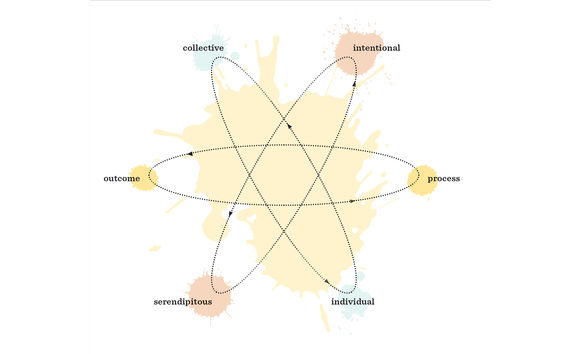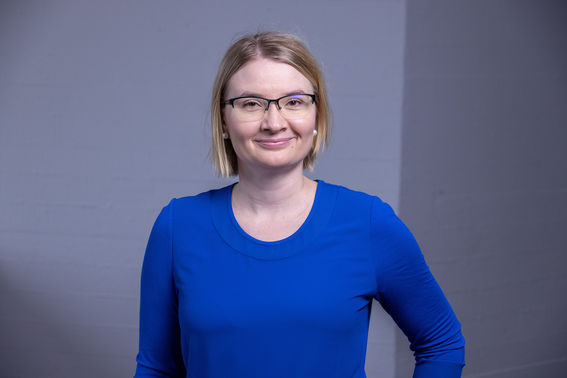Radical creativity
We enable experimental activities that challenge the status quo.

Organizations and communities across the globe are reaching for novel solutions and innovation for human and planetary flourishing.
The concept of radical creativity in Aalto University's strategy has generated much debate internally, and it is interpreted and articulated in very different ways across the university. The university's own researchers in the fields of innovation, design and change management wanted to study the phenomenon, and began to explore how the wording of strategy influences organisational norms, identity and ways of working.
The research began with 54 interviews that mapped how members of the Aalto faculty perceive and implement radical creativity in their work.
The first phase of the study, a not yet peer-reviewed interview summary, is openly available and can be downloaded below. The researchers hope the report will contribute to further discussion and insights within Aalto around the ambiguous strategic expression, radical creativity.
Based on the interviews, members of the Aalto community are interested in how others have understood the new concept.
The report highlights that radical creativity is understood in many different ways: as a process, as an outcome, at the individual level and as collaboration. It is also strongly linked to more open, interdisciplinary collaboration and experimentation as well as exploration of the unknown with a higher risk, impact and future-focused topics.

‘What was even a little surprising in the responses, was how close radical creativity was perceived to be to the core of research in all disciplines,’ says Assistant Professor Tua Björklund, one of the interviewers and authors of the report and the director of the study.
Responses reflecting on the concept of radical varied from paradigm shifts and disciplinary transformation to concrete examples of knowledge from another field being applied to a new context or unusual ways of doing things.
What is essential, however, is the strategic incentive to think bigger – beyond the incremental development. ‘Even if a scientist's or a teacher's own discipline is not related to creativity, innovation or development, understanding radical creativity can help enable scientific breakthroughs,’ explains Björklund.
The researchers suggest that by making visible and articulating the different manifestations of radical creativity (processes–outcomes, intentional–serendipitous, individual–collaboration), it will be easier for staff to perceive similarities and differences, which will, in turn, increase opportunities for radically creative collaboration and make it run more smoothly.
‘Instead of everyone sharing the same definition about radical creativity, it might be more useful to increase understanding of the different approaches, and what they might add to your work and your field. This could inspire people to see connections and opportunities as well as better understand other disciplines,’ Björklund says.
The interviews highlighted challenges with university and research funding that holds off radically creative research that does not fit into existing funding models. Despite this, there is still room for debate about what directions we as a community want to take within the current framework.
‘If we want to be known for radical creativity, what could we do differently? What would we as a community like to focus on and how? This is the kind of discussion we would like to start.’
During the autumn and spring, the Aalto Design Factory research team has reserved time to present their findings in more detail, for example at department meetings or events where it would be beneficial to discuss how people from their own school or field comprehend radical creativity could open up new paths.
The research team offers two options for presenting the results to the Aalto community:
Further information:
Tua Björklund , Assistant Professor, Aalto University Design Factory
+358 50 511 3182
tua.bjorklund@aalto.fi
The 18-month Conceptualizations of Radical Creativity in Transdisciplinary Networks (CREATNet) is a joint research project of researchers from the School of Engineering, the School of Arts, Design and Architecture, the School of Business and the School of Science. It received Aalto University's internal Radical Creativity research seed funding in spring 2022.
Tua Björklund, Ville Eloranta, Niina Nurmi and Masood Masoodian and their research teams will be diving into questions such as:
For the research project, this represents a first step in a longer process of data collection and analysis.
Researchers at Aalto University's Design Factory, led by Tua Björklund, conducted 54 interviews of Aalto's faculty members between April and June 2022. The interviewees represented all the six different schools at Aalto, and interviewees were invited from each department, drawing on Aalto personnel directories and networks. The target was to obtain as diverse perspectives and experiences of academic faculty as possible from lecturers to professors.

We enable experimental activities that challenge the status quo.


